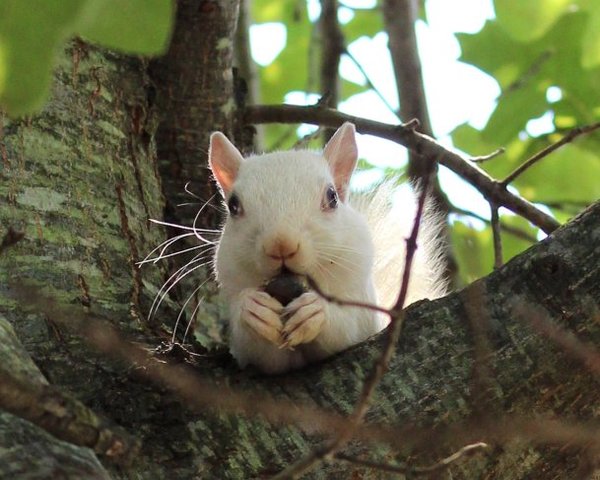
Author: Stacy Wiedower
Publisher: Commercial Appeal
11/3/2013
In the many hours he's spent in the woods in his lifetime, Michael Baty had never seen an albino squirrel — or an albino animal of any sort.
"I hunt all the time, and I'm in the woods all the time," said Baty, owner of Chestnut Hall Furniture & Interiors in Germantown and its accompanying store, At the Cabin.
So Baty was surprised when his first all-white animal sighting happened not in the wilderness but in the midst of urban sprawl. Chestnut Hall's long row of windows fronts Forest Hill-Irene Road, and Baty was looking out of one when he spotted a white squirrel at the base of a tree.
"I pinched myself a little," he said. "I realized from being in the woods so much and paying attention to squirrels throughout my life how rare that was and how neat it was to be here at the store watching her go about her daily routine."
It turns out it is pretty rare, though not unheard of, to spot an all-white squirrel. Sightings occur regularly in areas ranging from Charlotte, N.C., to Exeter, Ontario, to Kenton, Tenn. In Austin, Texas, sightings of white squirrels on the University of Texas campus are purported to bring good luck (and potentially good grades).
However, it isn't certain that a squirrel is albino just because it's white from head to toe. Albino squirrels can't produce melanin, which means they have no pigmentation anywhere on their bodies, and are generally recognized by their pink or blue eyes.
Dr. Bob Glesener, a retired professor of biology and ecology at Brevard College, has made the white squirrel phenomenon an area of study throughout his career. In his hometown of Brevard, N.C., white squirrels are spotted commonly enough that the town maintains the moniker "Home of the White Squirrel."
Brevard's variety of white squirrel is not albino but a type of squirrel researchers in the town have named the "Brevard white variant." These squirrels, a white example of the Eastern gray squirrel, have a mostly white coat with a few distinctive markings.
"The Brevard one is kind of unique in that it has a white coat and dark eyes, but it has a head patch and stripe down the back that expands over the shoulder and looks like a saddle," Glesener said. "Most of the white squirrels that pop up throughout the range of the gray squirrel are something called ‘leucistic,' not albino."
Leucistic squirrels have white coats and dark eyes, and they appear to be the product of a recessive gene in the common gray squirrel. According to Brevard's White Squirrel Research Institute, leucistic squirrels are thought to have "spontaneous mutants of some gene that delegates the use of the pigment (melanin) gene, not mutants of the melanin gene itself." That means melanin is produced only in the animals' eyes, but not in their skin or hair.
In the case of Chestnut Hall's resident white squirrel — named Blanche by a nearby shop owner — it's unclear whether she's albino or leucistic, though her dark eyes appear in photos to have a blue cast.
"These leucistic ones have dark eyes, and that's probably what the Memphis squirrel is," Glesener said. "We've had reports throughout Tennessee and throughout the whole range of the gray squirrel."
However, Glesener added, he's "always relied on self-reporting by the observer." And he's learned that in Olney, Ill., home to another pocket of white squirrels, the animals are likely albino.
"John Stencel, formerly of Olney Central College, not only reports that their squirrels are true albinos but there are a handful of other colonies, one of which is in Kenton, Tenn., about 100 miles northeast of Memphis," Glesener said.
He's aware of at least one other sighting in the Memphis area, and, he added, "I can't dismiss the possibility that they are albino, especially considering the proximity to Kenton."
The staff at Chestnut Hall grew so fond of Blanche in the time she spent outside the shop that they watched her, photographed her and even commissioned a wildlife artist — Sue Key of Birmingham, Ala. — to paint a portrait of her that now hangs inside the store.
"She was immediately adopted by everybody here," Baty said. "On Facebook, one of our customers wrote, ‘I might have known Chestnut Hall would not have a regular squirrel; they'd have a designer squirrel.' We called her Blanche, the Designer Squirrel."
The shop's staff hasn't had a Blanche sighting in a few weeks; she appears to have moved on to other trees on other city sidewalks.
"I knew every time I saw her that it might be the last time I ever saw her," Baty said.
Whether albino, leucistic or some other variant, Glesener likens a white squirrel sighting to finding a four-leaf clover.